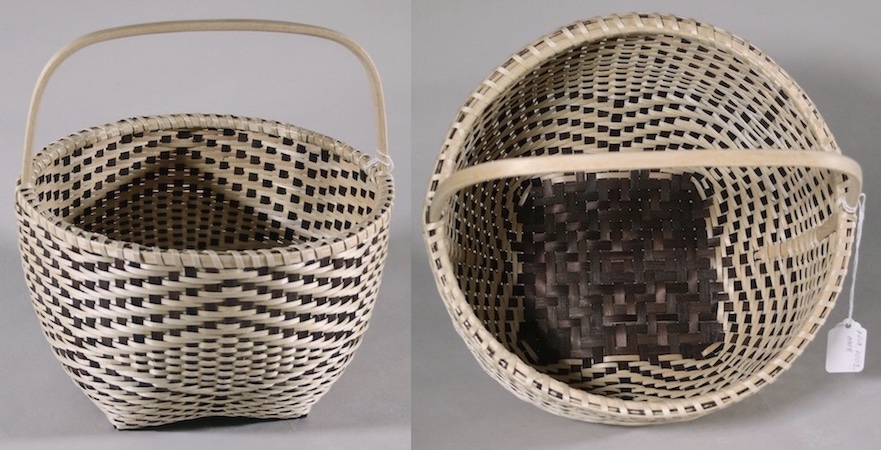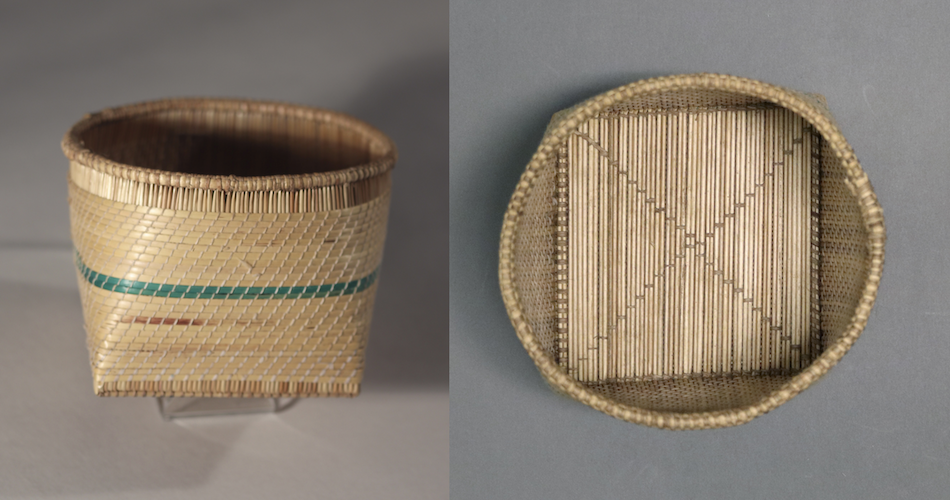The spare, simple forms of utility baskets are as beautiful as they are useful. Wabanaki basket makers initially made ash baskets to fulfill different needs. The fronts of early pack baskets were rounded to lay better in the bottom of canoes. Later, these sturdy baskets were sold for industrial and agricultural uses. Demand for utility baskets decreased with the introduction of plastics and international competition following World War II, but artists have continued to innovate using these historical forms. Fred Tomah (Houlton Band of Maliseet) learned how to make baskets from his grandfather and uncles. Throughout his life, harvesting ash and weaving baskets transported him back to the basket making shop in his grandfather’s backyard. There, up to eight men would work as a collective to pound logs, shave splints, and churn out baskets for various buyers ranging from the Sears, Roebuck & Co. in Augusta, Maine, to fish-processing plants.[1]
Fred Tomah moved away from home to be in the military in the 1970s. When he returned, he began making baskets again and continued to do so throughout his life. He used color to enhance the refined shapes of his baskets. Along the way, he discovered a connection between basket makers in his own family and Shaker baskets. He shaped his Katahdin series of baskets, like this one, around Shaker quatrefoil basket forms.[2] A pattern of interwoven light and dark splints rise and fall in gentle peaks around the sides of the basket. On other baskets in the series, the pattern falls into valleys. Mount Katahdin is a sacred place for the Wabanaki. Tomah imagined his series of baskets as vessels to carry plant medicine or herbs. The four corners produced around the quatrefoil mold might additionally represent the Maliseet, Passamaquoddy, Penobscot, and Mi’kmaq as the four tribal members of the Wabanaki Alliance. As a leader of his community, Tomah was integral to the movement for federal recognition of the Maliseet tribe, which was eventually granted in 1980.[3]
This basket is too small to hold very much, and if filled the beautiful sweetgrass inside would disappear. If you lean in close, you can still catch the grass’s scent. Across the basket’s base, two layers of carefully chosen sweetgrass reeds lay straight and flat, stitched one atop the other rather than interwoven. The artist, Caron Shay (Penobscot Nation), turned these standards at crisp right angles to support the sides of the basket, where they carry the square base upward toward a circular rim. Tight stitches in thread hold thin ash weavers to the sweetgrass standards. Two strips of ash dyed teal wrap around the basket’s middle. The straight weave shows a departure from Caron Shay’s typical work, which normally features tight curls and twisted points. It could be tempting to say this basket is less embellished, but Shay’s skill shines through in the seeming simplicity of the weave. Shay learned to weave by watching her parents as a child but did not begin to make baskets in earnest until 1993 when her mother passed. Afterward, her father started calling her, asking Shay to come and weave with him. Today, she teaches her own grandchildren how to weave.[4]
[1] David Shultz, Baskets of Time: Profiles of Maine Indian Basket Makers (Kennebunkport: Home & Away Gallery, 2017), 140.
[2] Shultz, 141.
[3] Amanda Cassano, Sunshine Eaton, and Shandiin Largo, “Innovation and Resilience: Across Three Generations of Wabanaki Basket-Making,” Bowdoin College Museum of Art, 2022, https://www.bowdoin.edu/art-museum/exhibitions/digital/innovation-resilience/project4.html#images-2.
[4] Caron Shay & Briana Randall, Hudson Museum/Maine Basketmakers’ Alliance (Orono: The University of Maine, 2014), https://umaine.edu/hudsonmuseum/caron-shay-briana-randall/.



